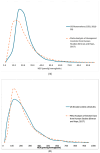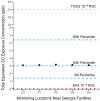Characterization of Background Exposures to Ethylene Oxide in the United States: A Reality Check on Theoretical Health Risks for Potentially Exposed Populations near Industrial Sources
- PMID: 40283821
- PMCID: PMC12026671
- DOI: 10.3390/ijerph22040597
Characterization of Background Exposures to Ethylene Oxide in the United States: A Reality Check on Theoretical Health Risks for Potentially Exposed Populations near Industrial Sources
Abstract
Ethylene oxide (EO) is an industrial chemical and sterilant that is released into ambient air from natural and unregulated anthropogenic sources that contribute to background exogenous exposure and from regulated industrial sources that contribute to additional exogenous exposure for near-facility populations. Metabolic processes contribute to substantial background endogenous exposures to EO, complicating the interpretation of the relation between total background exposure and the health significance of added industrial exogenous exposure. In 2021, Kirman and colleagues characterized the total and endogenous equivalent background concentrations for U.S. populations, which are substantially greater than the USEPA 2016 EO cancer reassessment risk-specific concentrations (0.00011-0.011 ppb), suggesting that the consideration of background exposure could be used as a reality check for the utility of the reassessment in managing EO risk for industrially exposed populations. New exposure biomarker data and background ambient concentration data for EO have become available since the 2021 assessment and are used here to refine the estimates of U.S. population total and endogenous equivalent background EO concentrations. Refined equivalent background concentrations as well as total equivalent exposure estimates for U.S. smokers provide context as to the health significance of near-industry population added exposure and a reality check for the utility of USEPA and TCEQ risk-specific concentrations in managing and communicating EO risk.
Keywords: ethylene oxide; managing and communicating risk; risk specific concentrations; total and endogenous equivalent background concentrations.
Conflict of interest statement
C.R.K., P.J.S., A.A.L., J.S.B., and R.R. have provided consulting services to sterilization facilities or industry associations with an interest in EO. This manuscript is solely the work of the authors. The authors declare no conflicts of interest.
Figures








References
-
- Kirman C.R., Li A.A., Sheehan P.J., Bus J.S., Lewis R.C., Hays S.M. Ethylene oxide review: Characterization of total exposure via endogenous and exogenous pathways and their implications to risk assessment and risk management. J. Toxicol. Environ. Health Part B Crit. Rev. 2021;24:1–29. - PubMed
-
- U.S. Environmental Protection Agency . Evaluation of the Inhalation Carcinogenicity of Ethylene Oxide (CASRN 75-21-8) in Support of Summary Information on the Integrated Risk Information System, EPA/635/R-16/350Fa. U.S. Environmental Protection Agency; Washington, DC, USA: 2016.
-
- TCEQ . Ethylene Oxide Carcinogenic Dose-Response Assessment. Texas Commission on Environmental Quality; Austin, TX, USA: 2020. CAS Registry Number: 75-21-8; In Development Support Document Final, May 15, 2020.
-
- U.S. Environmental Protection Agency . Summary of Public Comments and Responses for the Reconsideration of the 2020 National Emission Standards for Hazardous Air Pollutants: Miscellaneous Organic Chemical Manufacturing Residual Risk and Technology Review. U.S. Environmental Protection Agency Office of Air Quality Planning and Standards Sector Policies and Programs Division (EE-143-01); Research Triangle Park, NC, USA: 2022.
MeSH terms
Substances
Grants and funding
LinkOut - more resources
Full Text Sources
Medical

